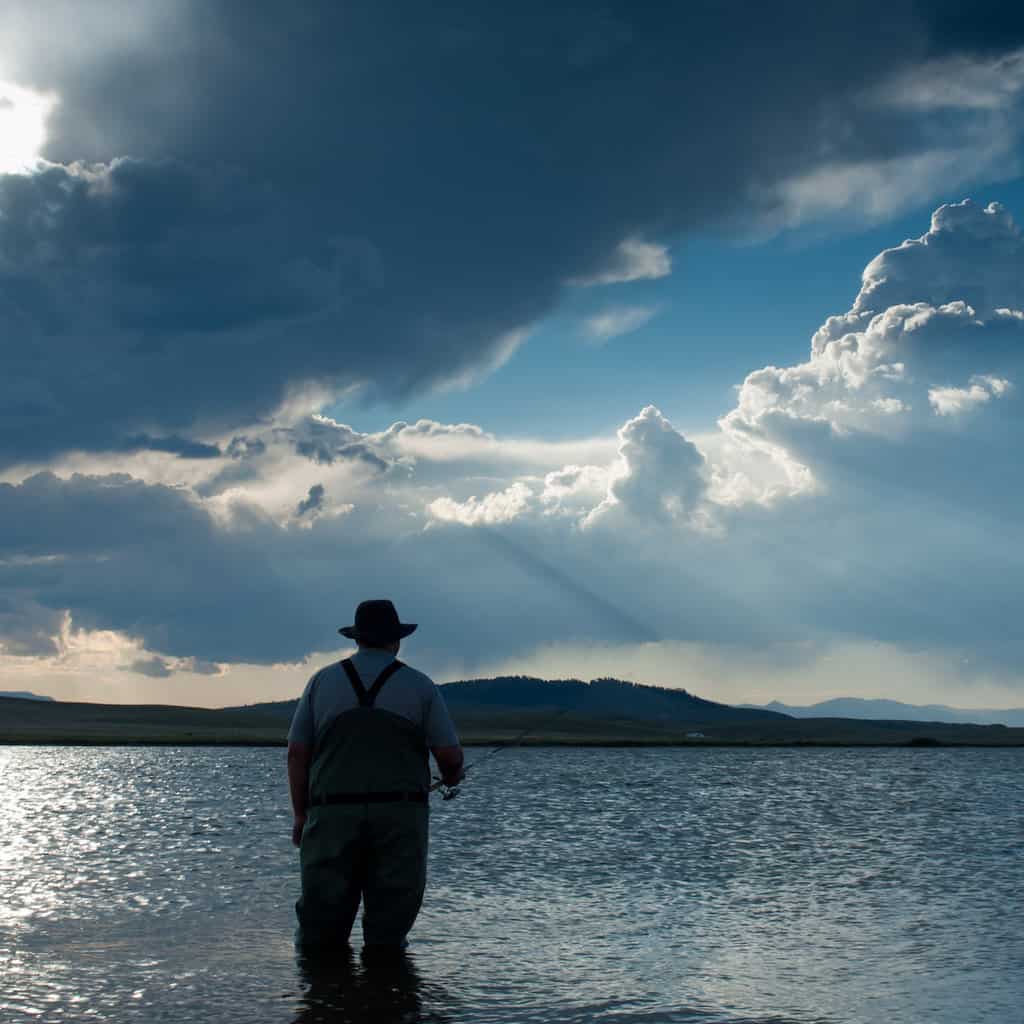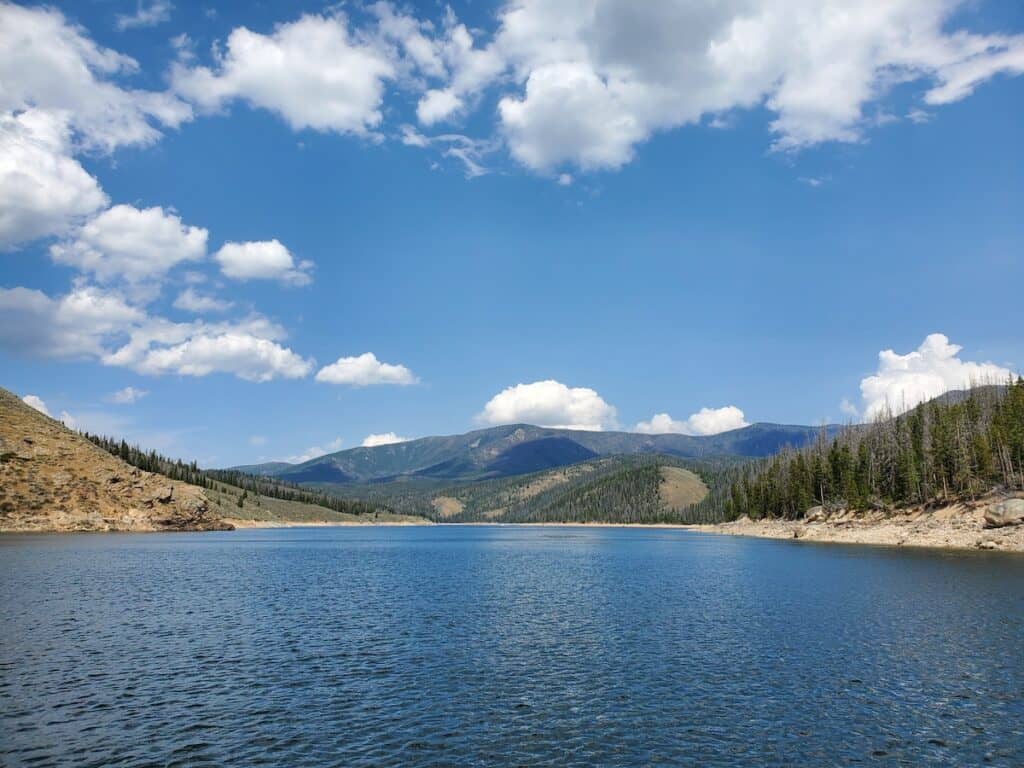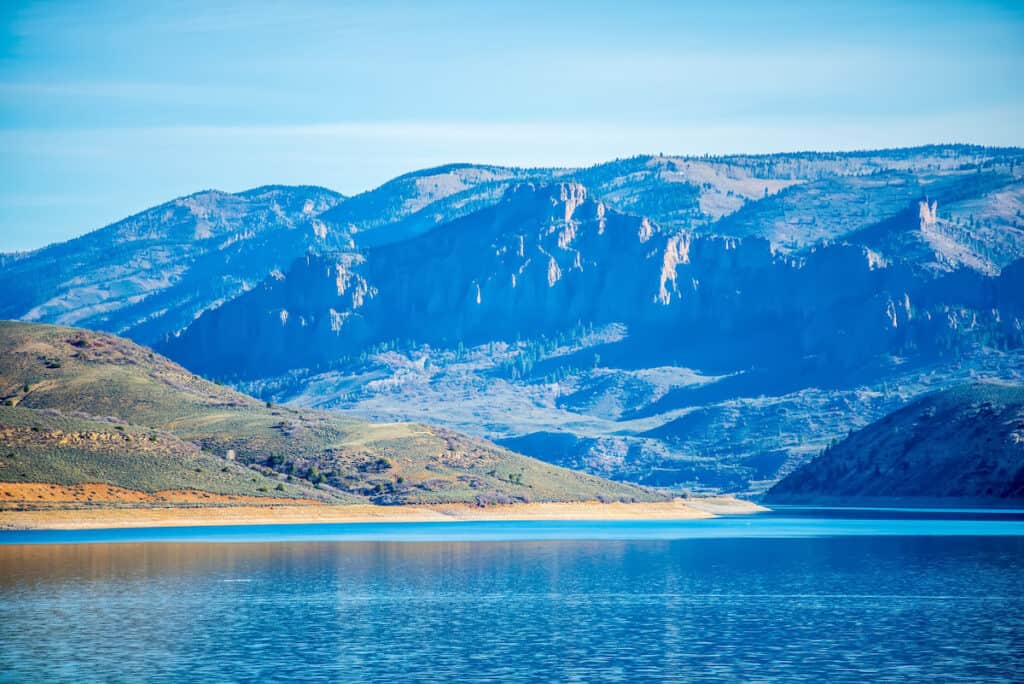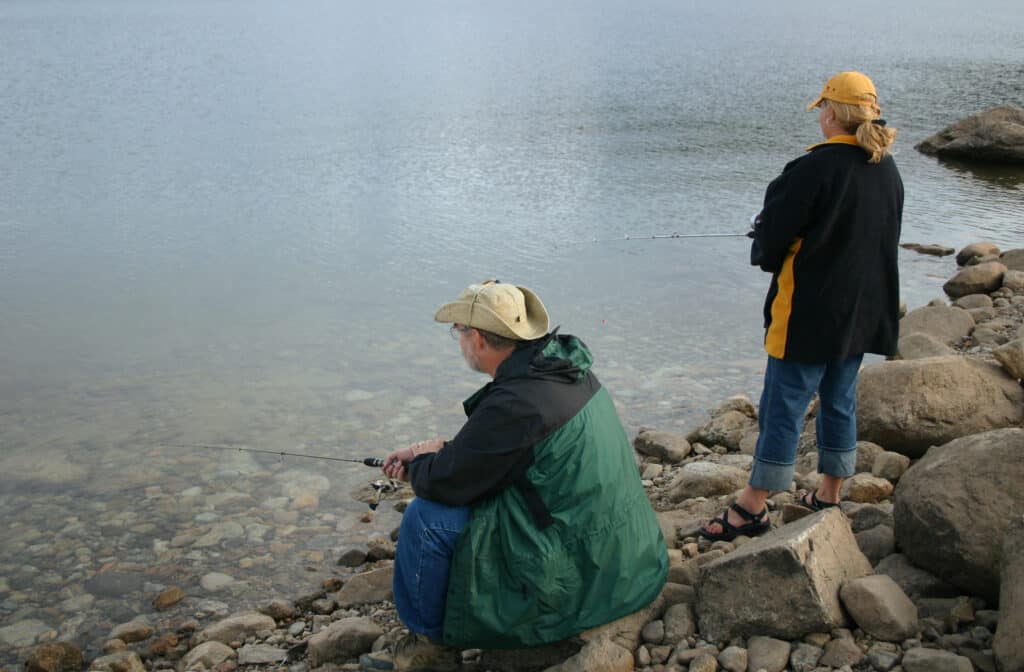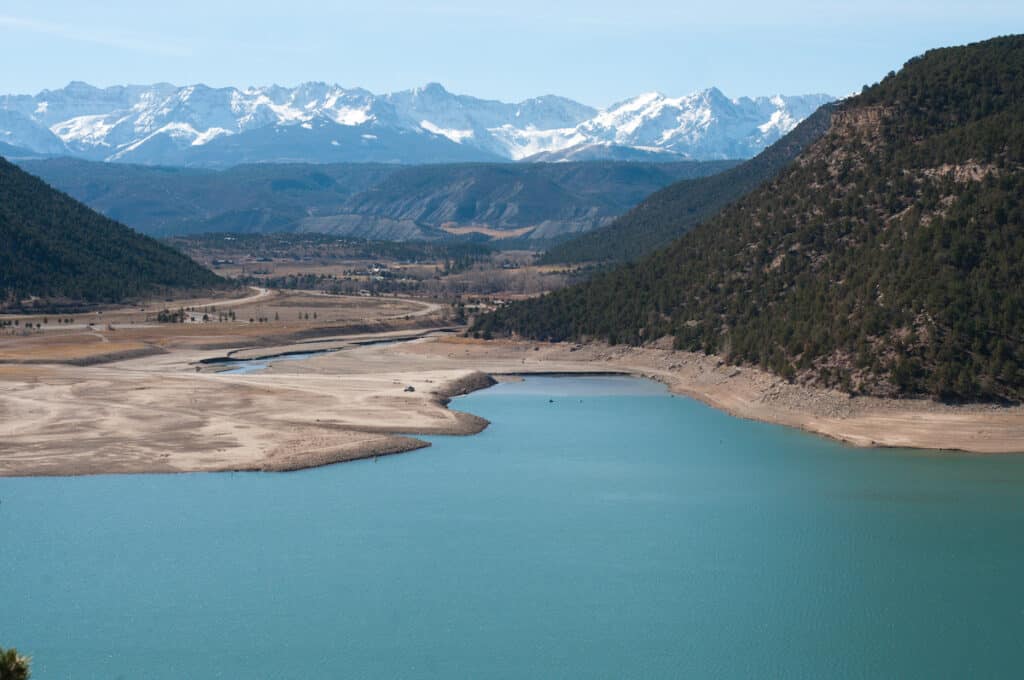While you may think of Colorado’s famous streams when it comes to trout fishing, the state’s best trout lakes speckled this beautiful state in blue and can give you a one-of-a-kind fishing experience.
If trout are your focus, the best lakes in Colorado are calling you.
Imagine sitting in a boat with the downriggers set as you troll along at a speedy 1.2 mph. It’s perfectly clear with a slight breeze across the water, and in the distance, you can see a few elk at the lake’s edge.
Your rod suddenly doubles over from the bite, and it’s fish on. After a 10-minute fight, you bring a 20-pound lake trout to the net. And it’s the smallest Mackinaw of the day.
Sounds pretty perfect, right? That experience can play out over and over again in Colorado.
High-alpine lakes with pristine, clear water hold giant brook trout that rarely see a lure.
Lake trout (almost) as big as a 1967 VW bus cruise through cold, clean lakes waiting for the right angler to set a new record.
Anglers target browns, rainbows, Mackinaw, cutthroat, tiger trout, and brookies across the Centennial State. The fish are plentiful and eager to take a lure.
We want to get you on the water to catch big trout at Colorado’s best fishing lakes. So we’ve made you a list of the top trout lakes in the state and topped it off with some tips and tricks for catching even the wiliest trout.
How to Catch Trout in Colorado
Trout fishing is one of the most difficult “easy” things you’ll undertake. The first time you go out, you might catch your limit or get skunked. Then, the 500th time you go out, the same might happen.
Consistently catching trout takes time. It also takes the right gear and bait, lures or flies. Getting skunked is not ideal, but it happens to everyone.
Start with a decent rod. If you’re taking on the alpine lakes and streams, go with an ultra-light trout rod. The trout way up there are usually smaller, and you’ll feel every bump and nibble.
Lake fishing for larger trout including rainbows, cutthroats, and browns calls for a bigger rod. Try a 6-foot or 6’6″ medium/light with fast action. The rod will have enough backbone for a bigger trout yet be sensitive enough for the smaller fish.
Use a 4- to 8-pound test main line. A lighter line is better for shy trout in crystal-clear water. Match the reel to the rod and line.
Nightcrawlers and PowerBait are great if you’re planning to catch dinner, but artificial lures and flies are a better option for catch-and-release fishing.
Kastmasters, Jake’s Lures, Rooster Tails, Joe’s Flies, and Rapalas are fantastic Colorado trout fishing options. Be sure to use varying retrieves until you find the right approach to entice them.
Catch More Trout
If you’d like to up your trout-catching game, even more, you’ll glean some excellent techniques and tips in our simple trout fishing guide.
The Best Trout Lakes in Colorado
Now let’s take a look at where to find these feisty fish. Read on for the best trout lakes throughout Colorado.
Head to the lake and spend a few days fishing in some of the most beautiful country around. Giant trout are waiting!
Spinney Mountain Reservoir
Head to Hartsel for arguably the best trout lakes in the state. It’s a quick hour east of Colorado Springs. Spinney Mountain Reservoir and Eleven Mile Reservoir are both epic fisheries.
Spinney Mountain Reservoir is one of the best trout waters in the country. It’s full of trophy rainbows. The browns and cutbows are plentiful, but the main draw is the chance to catch a trophy rainbow. It’s open from April to October.
Shore fishing can be excellent, and access is easy to find. Bring your waders or a float tube to get out past the weeds/marshy sections.
There are no services or supplies (that includes lures and flies) at Spinney, so pack in what you need or hop over to nearby Eleven Mile Reservoir to get what you need.
Morning fishing is the best time here, with the occasional hatch bringing big trout right to the surface. Load up with your favorite dry flies for the chance at a hatch.
Include Woolly Buggers in different sizes along with several weight options to get to the right depth. Nymphs, scuds, and terrestrials also are a must in your fly box. With the variety of bugs coming off the water, you’ll be glad you brought the lot.
Don’t leave your spinning rod at home. It gets windy here, so fly fishing dies off early. Try Kastmasters, crayfish imitations, and Rapalas. Trolling Needlefish is always a good option.
The lake has very strict regulations. You can keep one fish over 20 inches in length. Everything else goes back in the water. Use barbless hooks for the best release. Check the current regulations for any changes.
The northern pike are self-sustaining, and the CPW would like you to keep them.
While you’re in the area, fish the South Platte River between Spinney and Eleven Mile Reservoir for some of Colorado’s best fly fishing.
Eleven Mile Reservoir
Eleven Mile Reservoir, also near Hartsel, is known for big trout and regularly produces rainbows, browns, and cutthroats in the 8- to 15-pound range. Those are monster trout.
Start your day near the Cross Creek area or the North Shore. These spots are known to provide consistent action. Fish deeper in the summer heat to avoid the weeds at Cross Creek.
Coyote Ridge and Rocking Chair are great spots with fewer weeds for the shore anglers.
Trolling Rapalas, Needlefish, and Kastmasters in the main lake are always productive.
Set up a weedless rig for shore fishing. A sliding weight with a 3- to 4-foot leader below will let the bait sit above the weeds while the weight will slide to keep the bait floating free.
Tasmanian Devils also work well on the lake, as do Woolly Buggers.
The main marina has a fully stocked bait shop and all the tips you need to find and catch fish. They’ll put you on some northern pike as well.
Between campgrounds at Eleven Mile State Park, plus hotels and other rentals, you’ll find plenty of places to stay in the area.
Delaney Butte Lakes
Delaney Butte State Wildlife Area gives you three lakes in one listing: North Delaney, South Delaney, and East Delaney lakes. The trio of lakes requires anglers to use artificial lures and flies, and they have huge, eager trout cruising around.
The biggest lake of the trio is North Delaney, which has a solid population of 10-pound brown trout. You would be wise to show up here during ice-off and toss some bigger Rapalas or any crayfish imitation patterns you have.
Summer fishing is likely to be slower than spring, though the prospect of hauling in a trophy makes it worth the trip. Try stripping a Woolly Bugger or May’s Identity Crisis in long strips with a decent pause between pulls.
Fall fishing can be epic. The browns are ready to fatten up for the winter and will attack lures. Trolling a Rapala or Kastmaster should do the trick.
Ice fishing is good here, with the prospect of a giant brown, though a decent cutty or cutbow more often will take your lure. Give your spot no more than 30 minutes before moving. If they’re not biting, don’t stay around a non-productive area.
Both South and East Delaney are full of big rainbows. Springtime and fall are the best times to fish for ‘bows, and catch rates on these lakes outpace North Delaney by a wide margin.
When East Delaney is hot, the fishing can be nonstop, with some massive rainbows showing up to play.
There’s plenty of camping around the area, and Walden, about 20 minutes from the lake, also has limited lodging and dining. It’s a very small town, so don’t expect the Ritz. Walden is a bit over a two-hour drive west of Fort Collins.
Lake Granby
Mackinaw, a.k.a. lake trout, are the real fish story at Lake Granby. The lake is about two hours northwest of Denver, near the town of Granby. Shadow Mountain Lake and Grand Lake are nearby.
The fisheries program at Granby is built around trophy lakers, perhaps to the detriment of the kokanee and rainbow they swallow regularly.
That doesn’t mean there aren’t any smaller and easier fish to catch. Trout plants throughout the year maintain catchable numbers of rainbows for the summer.
If you’re new to lake trout fishing, realize they can eat fish up to about half their size. Recent sampling in the lake returned a laker with a 13-inch kokanee in its mouth, partially digested.
Give them what they like by targeting lake trout with kokanee and rainbow patterns. Your best bet is to find a school of kokes and fish a few feet below it. The bigger trout will cruise under the school, waiting for one of the smaller landlocked salmon to get out of position or show signs of injury.
Ice-off is huge at Lake Granby. The lakers move shallower in the spring to target the kokanee and rainbows, meaning bank anglers have their best chance at giants in the early season.
Rapalas and Kastmasters or tube jigs tipped with sucker meat are great options.
Rainbow fishing can be excellent in the spring and good throughout the summer. Fishing deeper will limit the number of ‘bows but get you closer to the big lakers.
Fall starts the laker feeding frenzy. They eat everything in their path just before they spawn in autumn. So head out then to boost your odds of hooking into a trophy.
Fishing doesn’t stop here just because Lake Granby freezes over. It’s also one of the top ice fishing lakes in Colorado.
Plenty of lodging and camping opportunities are around the area, with Granby being the perfect base camp to explore Lake Granby and other great fishing lakes and rivers.
Blue Mesa Reservoir
Blue Mesa Reservoir is a massive Southwestern Colorado lake with huge browns and lakers. You can easily access this lake from Gunnison, which has everything you need for lodging, food, and gear.
Rainbows, browns, and lake trout are the main attractions here, and you may find plenty of them.
Blue Mesa is a long, deep, cold reservoir carved with underwater canyons. The depths reach over 300 feet in spots, most of which are full of lake trout.
Lakers have dominated the lake for years, and the Colorado state record topping 50 pounds comes from here. It’s not unheard of to catch a 40-pound mack while trolling in the 120- to 200-foot range.
Spring brings an excellent opportunity for shore anglers to catch Mackinaw as they move into the shallows to grab a bite after a long winter. Most lakers here are in the 5- to 20-pound range.
The CPD recommends keeping a few pups while fishing to thin the numbers a bit to encourage the growth of the larger lakers.
Try vertical jigging with sucker meat and trolling with Needlefish, Rapalas, Kastmasters, and Flatfish.
Typical bait and tactics work like a charm for the rainbows in the lake, and you should be able to catch them from shore.
Blue Mesa Reservoir is in the Curecanti National Recreation Area.
Twin Lakes Reservoir
Twin Lakes is known for its big browns, rainbows, cutthroat, and mackinaws. It’s not as famous as the lakes around Hartsel, but it’s also significantly less crowded.
Located 25 miles south of Leadville, and a little over two hours from Denver, this cold-water lake has some giants cruising its depths. How about 35-pound macks on the regular?
Browns are a good target in the spring and fall, while anglers catch rainbows throughout the year.
Ice fishing is good for rainbows and Mackinaw, though it can be finicky. Sometimes you’ll struggle to bring in any fish, while other trips will be nonstop action.
Spring is the best time here, with fall being a close second. The lake trout are hungry in the spring, as are the browns.
Standard tactics should work for the macks. For example, tube jigs tipped with sucker meat jigged vertically will usually do well.
Troll Rapalas in 60 to 100 feet of water for big lakers and browns.
Summertime offers good rainbow action from shore in the mornings.
There are plenty of places to stay, and camping options are good.
Stagecoach Reservoir
Stagecoach Reservoir is a fantastic spot for big brown trout and giant northern pike. The lake is 20 miles south of Steamboat Springs.
Stagecoach isn’t the type of lake you stop by for a few hours. Instead, plan a trip and camp out or stay at one of the lodges nearby.
To help seal the deal, besides fishing in the lake, the Yampa River below the lake is epic fly fishing for giant rainbows and browns. Above the lake also has some fantastic rainbow action. Well downriver near Craig, the Yampa becomes one of the best smallmouth bass fisheries in Colorado.
The lake itself is no slouch, either. Toss a Kastmaster or Joe’s Fly from shore or a boat and be ready for a violent hit from an eager brown.
The south and west shores are accessible, with the south end having the best fishing. Try near Morrison Cove for your best shore action.
Speed boating is popular here, so you’ll have to deal with the power squadron on the weekends. So be prepared to fish early.
Stagecoach State Park is located at the reservoir.
Ridgway Reservoir
Ridgway Reservoir offers excellent rainbow and brown trout fishing in Southwestern Colorado.
The lake gets fished pretty heavily in the summer, and watersports are popular here. Weekdays are better times for fishing than weekends. Spring and fall are ideal.
Rainbows are stocked regularly and provide easy fishing for the kids. Browns grow big here and will test the seasoned anglers in the boat.
Shore fishing is best in the Dallas Creek and Mears Bay Cove areas. If the trout aren’t biting, switch bait and try for the smallmouth bass that overwhelm the lake at times.
Hit the inlet from a boat with black Woolly Buggers for a good chance at the larger holdover rainbows. Try minnow patterns, crankbaits, and jigs tipped with sucker meat for huge browns here.
Located a quick 1½ hour drive south of Grand Junction or a bit farther heading north from Durango, there are plenty of places to eat and stay near the lake.
Camping is readily available as well. Check Ridgway State Park for information.

